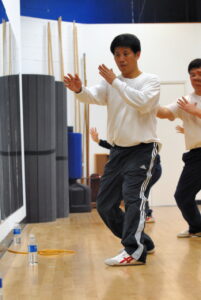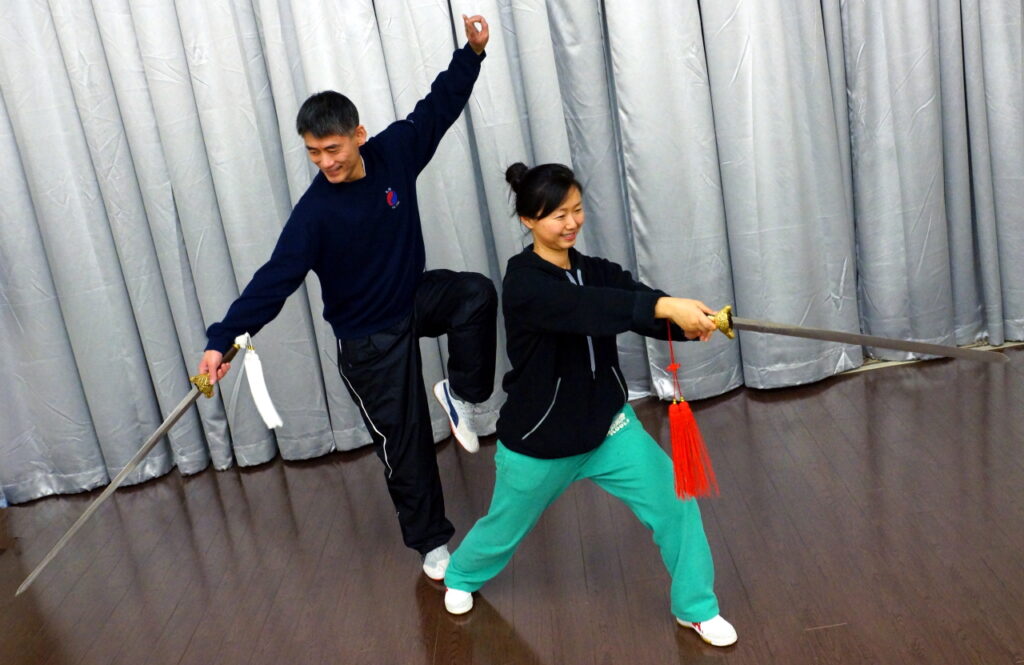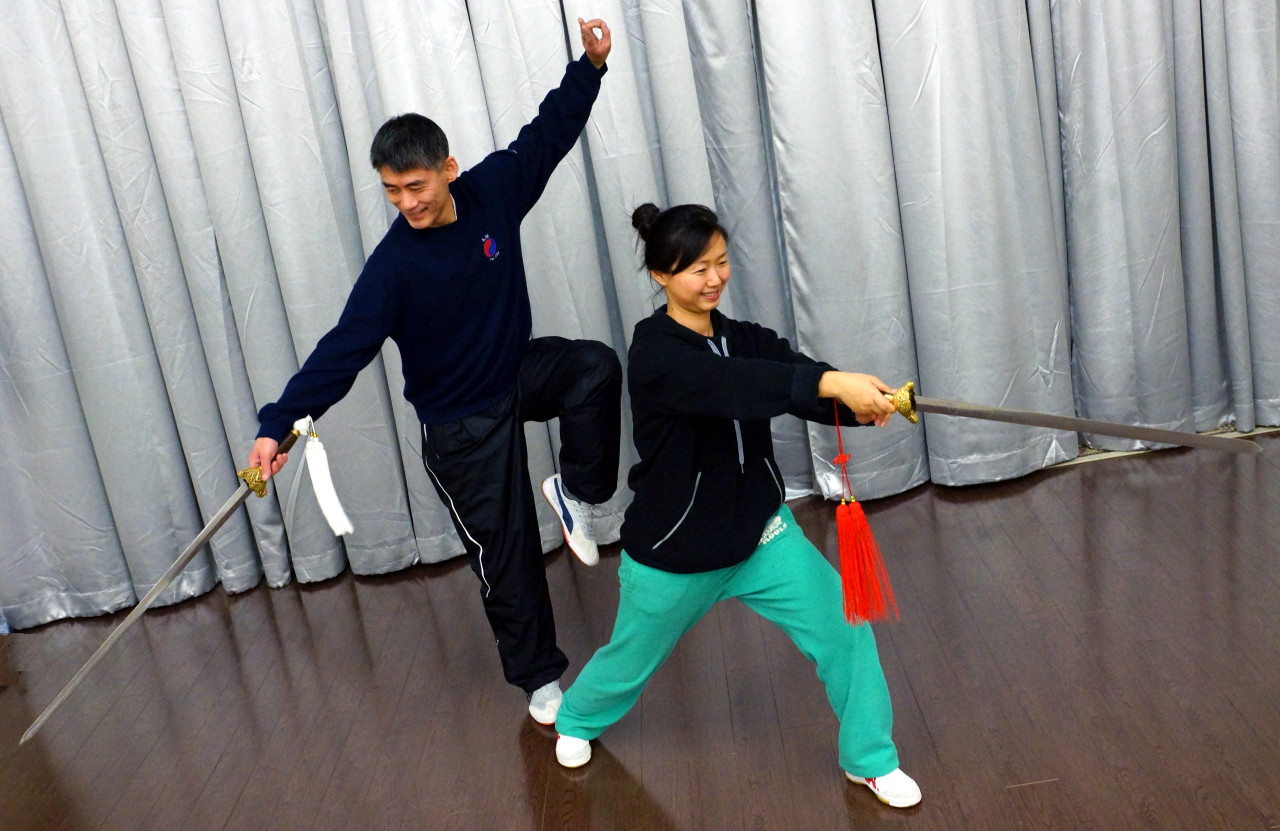While in the Basics classes, people are learning basic movements and positions as well as much of the terminology. In the advanced classes, we go beyond. In the Basic classes, everyone is mostly just following and copying what they see.
In the advanced tai chi learning path, people start to understand why these basic concepts exist and how to leverage these concepts to be able to move fluently. They’re learning more complex series of movements which challenge their balance and ability to be centred or grounded even when the movements and postures become more intricate and complicated.
As we touched upon in the last blog, the next step in the learning path after the Basics class is choosing either a Yang Style or a Chen Style tai chi forms class.
Tai Chi Forms (or Taolu)
 A Tai Chi form is a series of moves that are executed continuously from one move to the next, similar to a choreographed dance routine. A traditional tai chi form will take somewhere between 20 to 30 minutes to complete. At the beginning, you have to learn and remember the sequence of moves in the routine called a form.
A Tai Chi form is a series of moves that are executed continuously from one move to the next, similar to a choreographed dance routine. A traditional tai chi form will take somewhere between 20 to 30 minutes to complete. At the beginning, you have to learn and remember the sequence of moves in the routine called a form.
Whether you’re good at memorizing or not, there’s more to being able to execute a form than just knowing the order of the movements. Being good at a form whether it’s the Yang Style or Chen Style form, it’s all in the little details of knowing how to shift your centre or dantian. And, at the same time, maintain optimal balance and postural strength with each upcoming movement or stance.
While you are achieving a certain amount of fluency with the moves, learning to apply tai chi concepts begins and continues to deepen with time. Using the choreography of the form, people learn to incorporate tai chi concepts into the movements, starting with the basic concepts then progressively layering on more difficult and complex tai chi principles into the movements. It may take 3 seasons to learn the basic movements of the form but a lifetime to learn and master tai chi concepts and principles.
A form is much like a dance. We can all learn how to achieve a level of competency so we can enjoy the basic form. To master a tai chi form takes years of practice to unleash and have our bodies understand both the art and science of fluid yet powerful movement concepts. The consistent long term practice makes it easier for us to remember movements while staying active and physically fit. And, some people enjoy perfecting a single form as a way of learning and achieving this understanding.
Some people like to explore the different styles of tai chi and understand the unique characteristics of each style, hence learning multiple tai chi forms. There is no rule or set path to learning tai chi. Learn from various forms as well as other advanced classes to continue understanding how to apply the concepts. Follow your heart and take the path that feels right.
Depending on people’s personalities and personal preferences, some like to mix it up to add variety and different challenges which teach us the same concepts from a different perspective.
Push Hands (or Tuishou)
 Push Hands is a sparring activity meant to teach us how tai chi principles are applied. Instead of learning a series of movements in a choreographed set, we learn to respond and react to an outside force or a partner. It is a practical application of tai chi skills taught in various forms practice and applying these skills and concepts to interactive live situations where your partner is constantly moving and shifting.
Push Hands is a sparring activity meant to teach us how tai chi principles are applied. Instead of learning a series of movements in a choreographed set, we learn to respond and react to an outside force or a partner. It is a practical application of tai chi skills taught in various forms practice and applying these skills and concepts to interactive live situations where your partner is constantly moving and shifting.
It is about learning to sense the outside forces and becoming aware of other people’s movements. In turn, we learn to become much more aware of our own movements. We’re challenging the practical application of movements we learned in tai chi forms. And, we’re learning new movements as a way to respond to forces applied on us from our classroom partners without losing our own centre of balance.
Most people do not learn tai chi for the purpose of martial arts, therefore learning push hands is not always the first thing that comes to mind. However, it can be an important aspect of the learning path and this class is another part of the path to understanding many of the tai chi principles. Without actual physical contact with another person, it may often be difficult to appreciate some of the nuances of tai chi concepts.
Push hands is a direct path to learning tai chi principles as opposed to learning movements. You can start push hands training after learning the basics but it`s recommended to practice at least one form prior to or concurrently with the push hands class. Alternatively, start by achieving some fluency with a form first before beginning Push Hands.
For those looking to learn the martial aspects of tai chi, push hands is an essential course on the martial arts path within tai chi. And, for those looking to master tai chi, push hands is a necessary practice to achieving a complete understanding of tai chi principles.
Weapons

Incorporating weapons into tai chi practice takes our training to a different dimension. It is difficult enough trying to control our own body to achieve the tai chi principles. Adding an inanimate object extends our physical awareness beyond the length of our arms. People learn to incorporate the movements of the weapons as an extension of our own bodies.
Weapons have a tendency to exaggerate and expose flaws in our posture, balance and other tai chi principles. So it is an excellent means to enhancing tai chi skills while conditioning the physical body and sharpening our mental focus.
Learning one of the tai chi open hand forms for a minimum of 2 years is a pre-requisite for any of the 4 types of weapons classes: spear, sword, broad sword and long pole. In order to extend tai chi principles to a weapon, it is necessary to be fluent with basic tai chi concepts for the physical body first. Without understanding how to access the dantian or how to maintain the physically sturdy bow stances, it becomes impossible to translate tai chi concepts of movement to the weapon being wielded during class.
Without the open hand forms experience, the movements used with the weapon in our hands becomes clumsy and dangerous to others in the class as well as to ourselves. Learning a weapon is both mentally and physically challenging. The physical challenge is obvious as the extra weight of the weapon adds a level of physical work not found in the open hand forms.
A couple of years of open hand form conditioning will ease the transition to the weapons classes. Even the mental focus that is required can be exhausting. Each person has to be vigilant and pay constant attention or the weapon will hurt us or someone else.
Once people are ready, they find that learning a weapon is a lot of fun. The child in us comes out to play all while we learn to master tai chi skills.
Weapons have a tendency to exaggerate and expose flaws in posture, balance and other tai chi principles. Weapons classes are an excellent means to enhancing tai chi skills, conditioning the physical body and sharpening mental focus. All of this while having a lot of fun learning to master tai chi.
The Tai Chi Learning Path
The rich philosophical roots of tai chi bring a wealth of knowledge and principles that can make learning tai chi a life long journey. Each person’s journey is different depending on what we each want to learn of tai chi.
Each person`s learning path is unique to them. After a couple of years of taking steps to master the basics followed by some open hand forms training, people keep it lively and interesting by mixing, matching and even re-learning with deeper perspectives and appreciation.
Regardless of the journey ahead, start with a visit to our studio to meet our tai chi community. And, we will help you get started in a Tai Chi Basics class so you will have the foundation needed to enjoy a lifelong journey in tai chi.

